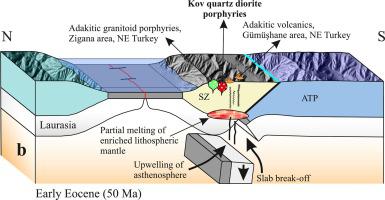当前位置:
X-MOL 学术
›
J. Asian Earth Sci.
›
论文详情
Our official English website, www.x-mol.net, welcomes your
feedback! (Note: you will need to create a separate account there.)
Tracking the timing of Neotethyan oceanic slab break-off: Geochronology and geochemistry of the quartz diorite porphyries, NE Turkey
Journal of Asian Earth Sciences ( IF 2.7 ) Pub Date : 2020-09-01 , DOI: 10.1016/j.jseaes.2020.104456 Orhan Karsli , Abdurrahman Dokuz , Faruk Aydin , İbrahim Uysal , Fırat Şengün , Raif Kandemir , José Francisco Santos , Tom Andersen
Journal of Asian Earth Sciences ( IF 2.7 ) Pub Date : 2020-09-01 , DOI: 10.1016/j.jseaes.2020.104456 Orhan Karsli , Abdurrahman Dokuz , Faruk Aydin , İbrahim Uysal , Fırat Şengün , Raif Kandemir , José Francisco Santos , Tom Andersen

|
Abstract The initiation of the break-off of the northern branch of the Neotethyan oceanic lithosphere is an important but poorly understood event in the geology of the Sakarya Zone (SZ) in northeastern Turkey. Although it is well-known that Latest Cretaceous intrusives (~70 Ma) and early Eocene adakitic magmatic rocks are present in the eastern SZ, the outcrops of the early Eocene non-adakitic rocks are very limited, and their tectono-magmatic evolution has not been studied. We describe a small outcrop of non-adakitic quartz diorite porphyry in the Kov area of the Gumushane region in northeastern Turkey. The genesis of these porphyries is significant in evaluating the syn- to post-collision-related magmatism. The LA-ICP-MS zircon U-Pb dating revealed that the Kov quartz diorite porphyries (KQDP) formed at ca. 50 Ma, coeval with adakitic rocks, and ~20 Myr later than the slab roll-back-related intrusive rocks. The KQDPs are calc-alkaline in composition and enriched in large ion lithophile elements (LILEs) and light rare earth elements (LREEs) and depleted in high field strength elements (HFSEs; e.g., Nb, Ta, Ti), with significant negative anomalies of Nb, Ta, and Ti but positive anomalies of Th, U, and Pb. Isotopic compositions of the samples show limited range of variation and slight enrichment of 87Sr/86Sr(t) (0.70489 to 0.70555), eNd(t) (−1.4 to −1.2) with TDM of 1.11 to 1.61 Ga. Pb isotopic ratios of the samples point to an enriched mantle source. They were likely crystallized from the melt that originated from an EM2-type spinel-facies subcontinental lithospheric mantle (SCLM), followed by the fractionation with insignificant crustal assimilation. The SCLM was metasomatically enriched, and the metasomatic agent was likely H2O-rich fluids rather than sediments released from subducting oceanic crust during the Late Cretaceous closure of the Neotethyan oceanic lithosphere. In conjunction with the geological background and previous data, we propose that the generation of the KQDPs resulted from a slab break-off event that caused ascending or infiltration of hot asthenosphere, triggering mantle melting. Such sporadic occurrences of the KQDPs, with coeval adakitic rocks in the SZ, are likely associated with the onset of extensional tectonics due to the earlier stage of slab break-off along the region during the early Eocene period.
中文翻译:

追踪新特提斯大洋板块断裂的时间:土耳其东北部石英闪长斑岩的年代学和地球化学
摘要 新特提斯大洋岩石圈北支断裂的开始是土耳其东北部萨卡里亚带(SZ)地质学中一个重要但知之甚少的事件。虽然众所周知,在深圳东部存在晚白垩世侵入岩(~70 Ma)和早始新世埃达克质岩浆岩,但早始新世非埃达克质岩露头非常有限,构造岩浆演化尚未确定。被研究过。我们描述了土耳其东北部 Gumushane 地区 Kov 地区的一小块非埃达克石英闪长斑岩露头。这些斑岩的成因对于评估与碰撞后相关的岩浆作用具有重要意义。LA-ICP-MS 锆石 U-Pb 测年显示 Kov 石英闪长斑岩 (KQDP) 形成于约 50 Ma,与埃达克岩同时期,和与板坯回滚相关的侵入岩晚约 20 Myr。KQDPs 的组成为钙碱性,富含大离子亲石元素 (LILEs) 和轻稀土元素 (LREEs),并缺乏高场强元素 (HFSEs;例如 Nb、Ta、Ti),具有显着的负异常Nb、Ta 和 Ti,但 Th、U 和 Pb 为正异常。样品的同位素组成显示出 87Sr/86Sr(t)(0.70489 至 0.70555)、eNd(t)(-1.4 至 -1.2)的有限变化范围和轻微富集,TDM 为 1.11 至 1.61 Ga。Pb 同位素比率样品指向一个丰富的地幔源。它们很可能是从源自 EM2 型尖晶石相次大陆岩石圈地幔 (SCLM) 的熔体中结晶出来的,然后进行分馏,地壳同化作用微乎其微。SCLM 交代富集,交代因子可能是富含 H2O 的流体,而不是新特提斯大洋岩石圈晚白垩世闭合期间俯冲洋壳释放的沉积物。结合地质背景和先前的数据,我们提出 KQDP 的产生是由于板块断裂事件导致热软流圈上升或渗透,引发地幔熔化。KQDP 的这种零星出现,在 SZ 具有同时代的埃达克质岩石,可能与早始新世早期沿该地区板块断裂的伸展构造的发生有关。交代剂可能是富含 H2O 的流体,而不是新特提斯大洋岩石圈晚白垩世闭合期间俯冲洋壳释放的沉积物。结合地质背景和先前的数据,我们提出 KQDP 的产生是由于板块断裂事件导致热软流圈上升或渗透,引发地幔熔化。KQDP 的这种零星出现,在 SZ 具有同时代的埃达克质岩石,很可能与早始新世早期沿该地区板块断裂的伸展构造的开始有关。交代剂可能是富含 H2O 的流体,而不是新特提斯大洋岩石圈晚白垩世闭合期间俯冲洋壳释放的沉积物。结合地质背景和先前的数据,我们提出 KQDP 的产生是由于板块断裂事件导致热软流圈上升或渗透,引发地幔熔化。KQDP 的这种零星出现,在 SZ 具有同时代的埃达克质岩石,很可能与早始新世早期沿该地区板块断裂的伸展构造的开始有关。我们认为 KQDP 的产生是由于板块断裂事件导致热软流圈上升或渗透,引发地幔熔化。KQDP 的这种零星出现,在 SZ 具有同时代的埃达克质岩石,很可能与早始新世早期沿该地区板块断裂的伸展构造的开始有关。我们认为 KQDP 的产生是由于板块断裂事件导致热软流圈上升或渗透,引发地幔熔化。KQDP 的这种零星出现,在 SZ 具有同时代的埃达克质岩石,很可能与早始新世早期沿该地区板块断裂的伸展构造的开始有关。
更新日期:2020-09-01
中文翻译:

追踪新特提斯大洋板块断裂的时间:土耳其东北部石英闪长斑岩的年代学和地球化学
摘要 新特提斯大洋岩石圈北支断裂的开始是土耳其东北部萨卡里亚带(SZ)地质学中一个重要但知之甚少的事件。虽然众所周知,在深圳东部存在晚白垩世侵入岩(~70 Ma)和早始新世埃达克质岩浆岩,但早始新世非埃达克质岩露头非常有限,构造岩浆演化尚未确定。被研究过。我们描述了土耳其东北部 Gumushane 地区 Kov 地区的一小块非埃达克石英闪长斑岩露头。这些斑岩的成因对于评估与碰撞后相关的岩浆作用具有重要意义。LA-ICP-MS 锆石 U-Pb 测年显示 Kov 石英闪长斑岩 (KQDP) 形成于约 50 Ma,与埃达克岩同时期,和与板坯回滚相关的侵入岩晚约 20 Myr。KQDPs 的组成为钙碱性,富含大离子亲石元素 (LILEs) 和轻稀土元素 (LREEs),并缺乏高场强元素 (HFSEs;例如 Nb、Ta、Ti),具有显着的负异常Nb、Ta 和 Ti,但 Th、U 和 Pb 为正异常。样品的同位素组成显示出 87Sr/86Sr(t)(0.70489 至 0.70555)、eNd(t)(-1.4 至 -1.2)的有限变化范围和轻微富集,TDM 为 1.11 至 1.61 Ga。Pb 同位素比率样品指向一个丰富的地幔源。它们很可能是从源自 EM2 型尖晶石相次大陆岩石圈地幔 (SCLM) 的熔体中结晶出来的,然后进行分馏,地壳同化作用微乎其微。SCLM 交代富集,交代因子可能是富含 H2O 的流体,而不是新特提斯大洋岩石圈晚白垩世闭合期间俯冲洋壳释放的沉积物。结合地质背景和先前的数据,我们提出 KQDP 的产生是由于板块断裂事件导致热软流圈上升或渗透,引发地幔熔化。KQDP 的这种零星出现,在 SZ 具有同时代的埃达克质岩石,可能与早始新世早期沿该地区板块断裂的伸展构造的发生有关。交代剂可能是富含 H2O 的流体,而不是新特提斯大洋岩石圈晚白垩世闭合期间俯冲洋壳释放的沉积物。结合地质背景和先前的数据,我们提出 KQDP 的产生是由于板块断裂事件导致热软流圈上升或渗透,引发地幔熔化。KQDP 的这种零星出现,在 SZ 具有同时代的埃达克质岩石,很可能与早始新世早期沿该地区板块断裂的伸展构造的开始有关。交代剂可能是富含 H2O 的流体,而不是新特提斯大洋岩石圈晚白垩世闭合期间俯冲洋壳释放的沉积物。结合地质背景和先前的数据,我们提出 KQDP 的产生是由于板块断裂事件导致热软流圈上升或渗透,引发地幔熔化。KQDP 的这种零星出现,在 SZ 具有同时代的埃达克质岩石,很可能与早始新世早期沿该地区板块断裂的伸展构造的开始有关。我们认为 KQDP 的产生是由于板块断裂事件导致热软流圈上升或渗透,引发地幔熔化。KQDP 的这种零星出现,在 SZ 具有同时代的埃达克质岩石,很可能与早始新世早期沿该地区板块断裂的伸展构造的开始有关。我们认为 KQDP 的产生是由于板块断裂事件导致热软流圈上升或渗透,引发地幔熔化。KQDP 的这种零星出现,在 SZ 具有同时代的埃达克质岩石,很可能与早始新世早期沿该地区板块断裂的伸展构造的开始有关。











































 京公网安备 11010802027423号
京公网安备 11010802027423号